牛津英语8B Unit3导学案
- 格式:doc
- 大小:501.50 KB
- 文档页数:65
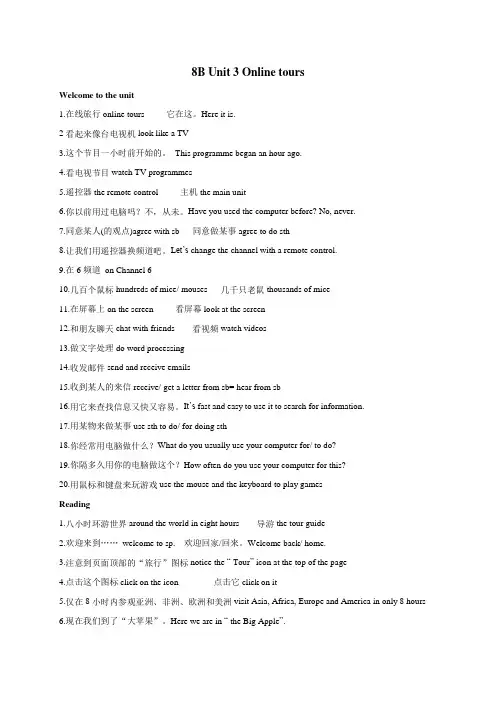
8B Unit 3 Online toursWelcome to the unit1.在线旅行online tours 它在这。
Here it is.2看起来像台电视机look like a TV3.这个节目一小时前开始的。
This programme began an hour ago.4.看电视节目watch TV programmes5.遥控器the remote control 主机the main unit6.你以前用过电脑吗?不,从未。
Have you used the computer before? No, never.7.同意某人(的观点)agree with sb 同意做某事agree to do sth8.让我们用遥控器换频道吧。
L et’s change the channel with a remote control.9.在6频道on Channel 610.几百个鼠标hundreds of mice/ mouses 几千只老鼠thousands of mice11.在屏幕上on the screen 看屏幕look at the screen12.和朋友聊天chat with friends 看视频watch videos13.做文字处理do word processing14.收发邮件send and receive emails15.收到某人的来信receive/ get a letter from sb= hear from sb16.用它来查找信息又快又容易。
I t’s fast and easy to use it to search for information.17.用某物来做某事use sth to do/ for doing sth18.你经常用电脑做什么?What do you usually use your computer for/ to do?19.你隔多久用你的电脑做这个?How often do you use your computer for this?20.用鼠标和键盘来玩游戏use the mouse and the keyboard to play gamesReading1.八小时环游世界around the world in eight hours 导游the tour guide2.欢迎来到……welcome to sp. 欢迎回家/回来。
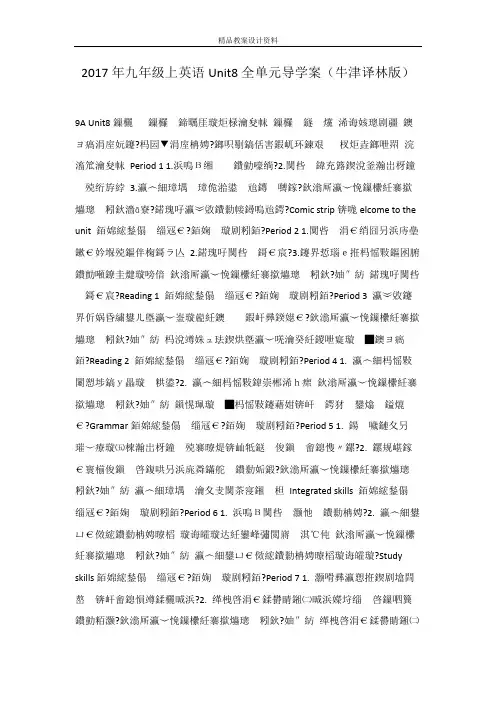
2017年九年级上英语Unit8全单元导学案(牛津译林版)9A Unit8浠诲姟璁剧疆鐭ヨ瘑涓庢妧鑳?杩囩▼涓庢柟娉?杈炬垚鎯呭喌浣滀笟瀹夋帓Period 1 1.浜嗚В?2.3.?鈥滃厛瀛﹀悗鏁欙紝褰撳?鍩瑰吇瀛︾敓鐨勬帹鐞嗚兘鍔?Comic strip锛哤elcome to the unit ??Period 2 1.鏉€妗堢殑鏂伴椈鎶ラ亾 2.?3.鑳界悊瑙e拰杩愮敤鏂囦腑鐨勯噸鐐圭煡璇嗙偣?妯″紡鍩瑰吇闃呰?Reading 1 ??Period 3 瀛︾敓鑳?鈥滃厛瀛﹀悗鏁欙紝褰撳?妯″紡銆?Reading 2 ??Period 4 1. 瀛︿細杩愮敤闄愬埗鎬у?2. 瀛︿細杩愮敤鍏崇郴浠h瘝鈥滃厛瀛﹀悗鏁欙紝褰?妯″紡€?Grammar??Period 5 1.?2. 鏍规嵁鎵?粌鈥?妯″紡Integrated skills缁冦€??Period 6 1. 浜嗚В?2. 瀛︿細鐢ㄩ€傚綋鐨勬柟娉曢槄鈥滃厛瀛﹀悗鏁欙?妯″紡瀛︿細鐢ㄩ€傚綋鐨勬柟娉曢槄璇诲皬璇?Study skills??Period 7 1. 灏嗗彞瀛愬拰鍥剧墖閰?2.鐨勭粨灏??妯″紡缂栧啓涓€鍒欎睛鎺㈡晠浜?Task ??Unit 8 Detective stories璇?棰?Comic strip and welcome to the unit 璇?鍨?鏂版巿璇炬椂1 璇炬椂鏁?瀛?鐩?鏍?1. To understand clues about a crime. 2. To read notes on four suspects and decide which suspect is most likely to be guilty.閲嶇偣1. To master the new words and useful expressions. 2. To make up a conversation in Part B. 1. To master the new words and useful expressions. 2. To make up a conversation in Part B. ?浜屾Teaching procedures Step1 Lead-in T: Do you remember in Unit 6 we have learned a horror film called 鈥淢urder in a Country House鈥? Can you tell me the main idea of this film? Step 2 Comic strip 1. Presentation: T: Do you like reading detective stories? Who is the famous detective in the novels? (Sherlock Holmes.) Show the picture of Sherlock Holmes, and describe the picture. (Talk about his special dressing with his magnifying glass and the pipe.) T: Today, Eddie is dressed like that. Let鈥檚see what happened. 2. Listen to the tape and answer some questions: (1) Why is Eddie dressed like a detective? (2) Is his job serious? (3) What is he really looking for? Check the answers by asking students. 3. Read the dialogue together. 4. Ask some pairs to act out the dialogue. Step 3 Welcome to the unit 1. Presentation T: Do you want to be a detective? How to be a detective? Here is a chance for you to try. The Class1, Grade 9 students are playing a game about guessing who is the murder. We can try together. 2. Show the detective鈥檚report to students. Ask one student to read. Tell students that we can know the time, the place, the victim and the notes of the suspects from the report. 3. Look at the information of four suspects together and ask some questions about it. Teach some new words at the same time. Try to explain the meanings of these words in English. Step 4 Discussion Work in a group offour. Ask students to discuss who is most likely to be the murderer and the reason. Then ask them to draw a picture of the person they think committed the crime in part B, and remind them that there is no right or wrong answers here. Step 5 Part B Daniel and Sandy are talking about the murder in Sun Town. Listen to the conversation and answer the questions: (1) Who does Sandy think is mostly to be the murder? Why? (2) Who does Daniel think is most likely to be the murder? Step 6 Consolidation ?1. Why__________ you __________(dress) like that? 2. Eddie鈥檚food has gone __________(miss). 3. The coats with blood were those ____________(murder). 4. His bedroom istoo_________(tidy). Let鈥檚_______(help) to clean it. Step 7 Homework 1. Read the comic strip and try to recite it. 2. Finish off the exercises in the workbook. 鏁欏?璇?棰?Reading (1) 璇?鍨?鏂版巿 2 璇炬椂鏁?瀛?鐩?鏍?11.1. To read a newspaper article about a murder. 2. To understand key vocabulary items. 3. To develop the four skills of the students. 1. To learn new words from the context. 2. To retell the passage. 1. To learn new words from the context. 2. To retell the passage. ?Teaching procedures Step 1 Presentation 1. Say: Good morning, everyone. First of all, let鈥檚watch a part of a film. 2. Say: Just now we saw a young man in the film. What did he do? Yes, he murdered the woman, his wife. He was the murderer. And his wife is the victim. (Write the two words on the Bb.) Learn the new words. Step 2 Listen and answer Now listen to the tape and try to answer some questions: 1. Who was murdered? 2. When did the murder take place? 3. So far how many suspects do the police have? 4. How old was the victim? 5. What鈥檚the victim鈥檚job? Step 3 Skimming 1. Ask the students to finish the exercise of Part B1, then check their answers by asking 2 pairs of students to read it. 2. Ask the students to work in pairs and tick out the main idea of the article. (slide show) the victim:clues: suspects: the police: 3. Check out their answers orally, then give out the answers on pieces of paper. 4. Interview: Work in groups of 8. Four work as the reporter, who is from the Golden TV, the other four work as Detective Lu. Interview about the murder. 5. Act their interviews out. 6. Guess: Who murdered the young man? 7. Finish the exercises in Part B2 on P110. Step 4 Practice 1. The drunk man__________(鍙戠幇) in the __________(闂ㄥ彛) of the neighbour鈥檚. 2. Mike is one of the ______________ (? who ___________(鎶㈠姭). 3. Theymust________() their air tickets 3 days before they leave. 4. His dog鈥檚_________(姝? made him very sad. 5. When she woke up, her headwas_________() 6. Have you seen anything_______________(鎬€鐤?? 7. He was last seen _______ (绂诲紑) his office at about 7 p.m. 8. Today he got up as early as ___________(寰€甯? 9. A young man_________________(璋嬫潃) last night. 10. Shall we meet at the __________(鍏ュ彛) to the cinema? Step 5 Homework 1. Remember the new words and phrases. 2. Retell the text in their own words. 鏁欏?璇?棰?Reading (2) 璇?鍨?鏂版巿3 璇炬椂鏁?瀛?鐩?鏍?1. To read a newspaper article about a murder. 2. To understand key vocabulary items. 3. To develop the four skills of the students. 鏁欏To learn the new words and the phrases in this part. To learn how to use the language points correctly. ?Teaching procedures Step 1 Revision Read the article more carefully and try to tell the following sentences T or F. If it is false, please correct the mistake. a) The victim鈥檚body was found in Valley Town. ____ b) The victim sold computer programs. ____ c) The victim worked in New Town. ____ d) It is possible that there was more than one attacker. ____ e) The victim had lots of enemies. _____ f) The victim was attacked with a gun. ____ g) The suspect is a short, fat man. _____ h) The police have arrested the murderer. _____ i) The victim鈥檚parents offered a reward for information. ____ Step 2 Reading Read the article by themselves forseveral minutes then ask 8 students to read one paragraph by one paragraph. While reading, after each paragraph, do some explanations about the difficult points. Also do some explanations about the title. Show the students more examples. Step 3 Important phrases see sb. doing sth. ---sb. be seen doing sth.鍋?see sb. do sth.---sb. be seen to do sth. ?at thescene/time of the crime ?鏃堕棿somewhere else鍦版柟be wounded with a knife bleed to death(bled) as a result 缁撴灉as a result of = because of a well-paid job 涓€浠芥姤be guilty of 鈥?feel/be guiltyat/for/about 瀵光€︹€︽劅鍒板唴鐤?charge sb. with (doing) sth. 鍥犳煇浜嬭€屾帶鍛婃煇浜?be charged with sth.у憡break into岀牬闂ㄨ€屽叆make enemies with sb. 涓庢煇浜烘爲鏁?suppose sb. to do sth. 璁炬兂鏌愪汉鍋氭煇浜?so far = up to now=until now=by now鍒扮洰鍓嶄负姝?breathe heavily/hard=out of breath 姘斿枠鍚佸悂Step 4 Practice 1. Finish the exercises in B3 and B4. 2. Show some pictures and key words, Ss try to retell the passage in their own words. Step 5 Consolidation 鐢ㄦ墍缁欒瘝鐨勯€傚綋褰㈠紡?1. Come here, jack. You _____________(want) on the phone. 2. No one ____________(travel) farther than the moon so far. 3. My food ______(go)_________(miss). 4. He is listening ______________(close) to the teacher. 5. They were ____________(scare) at the strange noise. 6. Look at the ___________(follow) examples, please. 7. A dictionary tries to tell the different _______(mean) of a word.8. The ____(interview) asked him how many crimes he had solved. 9. What is his____________(high) 10. There were more than one _______(attack). Step 6 Homework 1. Remember the language points. 2. Preview Grammar. ?璇?棰?Grammar 璇?鍨?鏂版巿 4 璇炬椂鏁?瀛?鐩?鏍?1. To understand and use defining relative clause correctly. 2. To use relative pronouns correctly: who/ which/ that. 1. To understand anduse defining relative clause correctly. 2. To use relative pronouns correctly: who/ which/ that. To use relative pronouns correctly: who/ which/ that.?Teaching procedures Grammar A Step 1 Lead-in Go through the explanation at the top of page112. Encourage students to ask questions if there is anything they are unsure of. Give students extra examples if necessary. Step 2 Reading 1. Explain the context. Millie is writing down some sentences about the murder case. Ask students to read sentences and decide which contain defining relative clause. 2. More able students underline the defining relative clauses. Allow less able students to work in pairs. 3. When all students have finished, ask two students to read the sentences. Ask them to stop after each sentence and the other students raise their hands and say if it contains a defining relative鈥檚clause. Check for mistakes and mispronunciation. 4. Ask students to think of some famous people from China. Encourage them to think of great people, rather than famous film stars. Write the names on the board. e.g. Yang liwei Yuan Longping He Zhengliang Step 3 Practice 1. Have students get into pairs and ask each pair choose a famous person from China. Ask them: What is this person famous for? How has he/ she helped China? How has he/ she helped society? 2. Each pair works out the answers to the questions for the person they have chosen. Then each pair reads out their answers. 3. Ask students to think about what structure the object clauses and defining relative clauses. Check out check the previewed exercises as usual. Step 4 Consolidation 鎶婁袱鍙ュ悎骞舵垚涓€鍙? 1. The boy is Tom. The boy has a round face. 2. The boy is Tom. The boy is smiling. 3. The boy is Tom. He sits in front of me. 4. The man is kind. Everyone likes him. 5. The woman got the job. We saw her on the street. 6. The teacher will give us a talk. We met the teacher yesterday. Step 5 Homework 1. Finish the exercises in the workbook. 2. Write ten defining relative clauses. 1. Remember the new words in this lesson. Grammar B Step 1 Lead-in Go through the table at the top of page 113. Then read the two example sentences. Tellstudents that the arrows show the people or things the relative pronouns are referring to. Step 2 Explanation 1.Explain the context of the exercise. Students can work in pairs or small groups. 2. Explain to students that both 鈥榳hich鈥?and 鈥榯hat鈥?can be used as relative pronouns to refer to things, but we normally use鈥榯hat鈥?as the relative pronoun when the noun it refers to is qualified by an ordinal number, e.g. 鈥榯he first鈥? 鈥榯he second鈥? 鈥榯he last鈥? 3.兘鐢╰hat鐨勬儏鍐碉細(1)?This is the best novel that I have read. (2) 褰撳厛琛岃瘝鏄痵omething, anything, nothing, everything, all绛変笉瀹氫唬璇嶆椂锛?Is there anything that I can do for you? (3) 褰撳厛琛岃瘝琚玹he only, the last, one of, just, all, little, few, any He is the only student that can sing this song. (4) 褰撳厛琛岃瘝鍚屾椂鎸囦汉鍜岀墿鏃讹紱I鈥檝e never heard of the people and things that you talked about just now. (5) 褰撲富鍙ヤ互who鎴栬€厀hich寮€澶寸殑鐗规畩鐤戦棶鍙ユ椂锛?Who is the man that is running? Step 3 Practice Simon and his friends are playing a game. Each person has to say say something about detective stories. Use who, which and that to complete the conversation. Finish the exercises in PartB2 and B3. Step 4 Consolidation 鐢ㄥ叧绯讳唬璇嶅~绌恒€?1. The boy____________ is playing ping-pong is my classmate. 2. The last e-mail __________ I received yesterday was from my sister. 3. I hate people ______________ talk much but do little. 4. The car ______ my father bought last month is very beautiful. 5. Yesterday Emily was wearing the new dress I gave her. Step 5 Homework Finish the exercises in the workbook. 璇?棰?Integrated skills 浜猴細璇?鍨?鏂版巿5 璇炬椂鏁?瀛?鐩?鏍?1. To get the information from the listening text. 2. To use information to complete notes and a report.1. To get the information from the listening text.2. To use information to complete notes and a report. 闅剧偣To use information to complete notes and a report. ?Teaching procedures Step 1Lead-in If someone has been kidnapped, can you ask Eddie for help? Who do you think find out the kidnapper? Now a child called Guan Fei has been kidnapped. His father, Guan Dawei asked the police for help. A police officer made some notes. Please read his notes and answer the following questions: 1. How old is the victim? 2. When did the crime occur? 3. Who are suspects? Step 2 Read and write Read the notes and complete the profiles with as much information as possible. Step 3 Listen and write If the police officer wants to find out who was the kidnapper, he should interview the two suspects. Here鈥檙e the police officer鈥檚interviews with them. Listen to their interviews carefully! 1. Listen and get the main idea. 2. Listen and complete the suspects鈥?profiles on Part A1, on Page 115. 3. Listen and check the answer. Step 4 Listen and answer Listen to the police officer鈥檚interviews with the two suspects again and answer the following questions: 1. What is Fan Yiming鈥檚job? 2. How long has Wang Gang known Guan Dawei? 3. What about Fan Yiming? 4. Did the two suspects go to the Guan鈥檚house on 28th December? 5. Where was Wang Gang at 8 p.m on 28th December? 6. Why did the kidnapper kidnap Guan Fei? Step 5 Read and write The police officer wants his assistant to write a report on the kidnapping case. Please help him complete Part A3. Use the notes and profiles on page 115 to help you. 1. Read and write. 2. Check the answers. 3. Let Ss read it freely. Step 6 Speak up Mr. Wu is asking Ss to think of some safety tips against crime. Listen to the tape and find out some safety tips: We should remember to 鈥? We鈥檇better shut 鈥? We shouldn鈥檛鈥? We need to guard 鈥? Step 7 Consolidation 1. He has no ___________(crime) record. 2. The girls ________________(kidnap) last night. 3. What do you think of _________(go) to the zoo today? 4. Jonson is a__________(kidnap). 5. He_______________(wear) a black T-shirt. Step 8 Homework 1. Revise this period. 2. Preview Study skills. ?璇?棰?Study skills 璇?鍨?鏂版巿 6 璇炬椂鏁?瀛?鐩?鏍?To learn to read a novel in the proper ways. To learnto read a novel in the proper ways. To learn to read a novel in the proper ways. 鏁欏?Teaching procedures Step 1 Checking & Leading ?1. He grew up in a _____________(wealth) family. 2. The young man is guilty of ______ (kidnap) a little girl. 3. It鈥檚_____ (danger) for children to go out alone at night. 4. You鈥檇better _______(not make) so much noise in the library. 5. We _______ (know) each other since we were young. 6. I鈥檓in no hurry ____________(see) him again. 2. Teaching the new words. 3. Do you often read novels? If so, do you read them word by word or just read quickly to get the general idea? Step 2 Learning 1. Read an excerpt from A Study in Scarlet on page117, then answer the following questions. 1) Who was the murderer, a man or a woman? 2) What was the murderer like? 3) How was the murder done? 4) What is the meaning of 鈥淩ache鈥?in German? 2. Read the excerpt again. Step 3 Practice There are some new words in the excerpt, and some sentences with more different words are left out. But you can still answer the four questions that help you get the general idea of the story. Can you answer two more questions? 1. Who were the other two detectives? 2. Who were the two detectives looking for? Step 4 Testing 1. 鈥昗hat did he do for a_______(live) last year? 鈥旾have no idea. 2. The murderer was a man. He was more than six ____(foot) high. 3. Jane planned _____(take) the wallet to the owner the next day. 4. To Kevin鈥檚_______(surprising), he found so many people playing beach volleyball in very hot weather. 5. I hope my advice willbe_________________(value) to you. Step 4 Homework 1.嬬浉鍏崇粌涔犮€?2. Preview Task.璇?棰?Task 璇?鍨?鏂版巿7 璇炬椂鏁?瀛?鐩?鏍?1. To match sentences with pictures. 2. To complete a story by filling in blanks.To write a detective story. To write a detective story.?Teaching procedures Step 1 Part A 1.Encourage more able students to describe the four pictures at the top of the page. 2. Ask questions: What is happening in picture 1? What is the man going to do in picture 2? Can you describe something about picture? What happened to Bruce? 3. Work in pairs. Ask students to match the sentences with the pictures by writing the correct letter in each box. 4. Ask students to read out their answers. Step 2 Part B Tell students to complete Part B individually. They should use the words from Part A to complete Millie鈥檚story. Check the answers as a class. And read it together, discuss the end of the story. Have a discussion in a group of four. Step 3 Part C 1. Look at the pictures in Part C. Ask six students to read out one speech bubble each. 2. Ask the following questions: Who do you think was murdered---a man or woman? How do you think he/ she was killed? Is there any blood? Who do you think is guilty? Why do you think he/ she is guilty? Step 4 Writing Explain the elements in writing detective stories. Tell students to write their own detective stories. Read their own detective stories. Step 5 Consolidation 1. Jim spends 3 days___________(finish) the work. 2. The next day, he____________(take) it to the factory. 3.He__________(leave) without___________(say) a word. 4. He is ill. He isunable_____________(get) up. 5. He said he _________(visit) Suzhou gardens many times before. Step 6 Homework 1. Do the exercises in the great English class. 2. Finish writing the detective story that they haven鈥檛finished in class.。
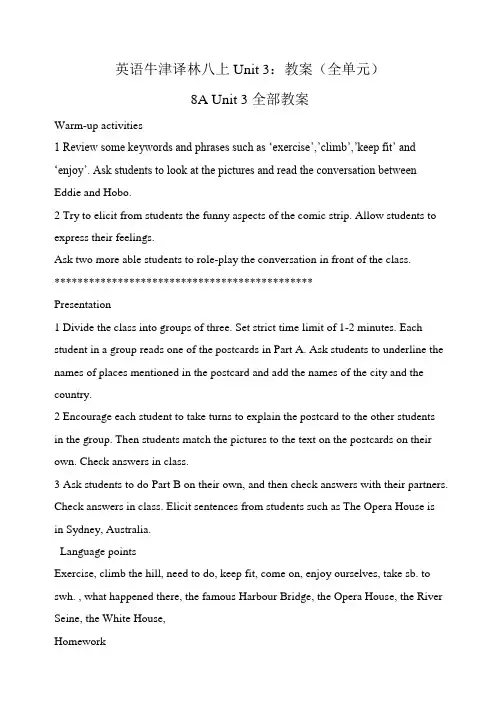
英语牛津译林八上Unit 3:教案(全单元)8A Unit 3全部教案Warm-up activities1 Review some keywords and phrases such as ‘exercise’,’climb’,’keep fit’ and‘enjoy’. Ask students to look at the pictures and read the conversation between Eddie and Hobo.2 Try to elicit from students the funny aspects of the comic strip. Allow students to express their feelings.Ask two more able students to role-play the conversation in front of the class.*********************************************Presentation1 Divide the class into groups of three. Set strict time limit of 1-2 minutes. Each student in a group reads one of the postcards in Part A. Ask students to underline the names of places mentioned in the postcard and add the names of the city and the country.2 Encourage each student to take turns to explain the postcard to the other studentsin the group. Then students match the pictures to the text on the postcards on their own. Check answers in class.3 Ask students to do Part B on their own, and then check answers with their partners. Check answers in class. Elicit sentences from students such as The Opera House isin Sydney, Australia.Language pointsExercise, climb the hill, need to do, keep fit, come on, enjoy ourselves, take sb. to swh. , what happened there, the famous Harbour Bridge, the Opera House, the River Seine, the White House,Homework1 Learn the language points by heart.2 一课三练P.253 Preview the Reading Part.****************************************************Revision1 Review key vocabulary according to the general ability of the class. Presentation (Reading A)1 Show the pictures of the World Park in Beijing. Elicit the names of the places or building.2 Explain to students the context of the letter. Ask Who’s writing the letter? Who’s Linda? Who’s she writing to?3 Read the letter to the class while students follow in their books. Try to read with expression.4 Divide the class into groups of three and allocate one part to each group. Ask them to find adj., verbs or phrases in the letter, which describe how Linda felt that day. They can either underline the words they do not know or write them on a piece of paper. Then go through the words students have underlined.5 Ask students in each group to go through the three sections in Linda’s letter and discuss the different feelings expressed in it.3 Ask students to write a schedule of the day out indicating places and movements only. Ask them to list the key words.6 Check students’ understanding. Ask comprehension questions.**********************************************Presentation (Reading B)1 Ask students to read the conversation on their own.2 Ask students to replace the underlined phrase with the correct words. Encourage less able students to find the words in the letter on page 36&37.3 Ask students to compare answers in pairs. Then ask two students to read out the conversation in class to check the correct answers.4 Ask students to write the list of new words and definitions in their vocabulary record books.5 Divide the class into pairs and ask them to read the conversation.**********************************************Presentation (Reading C)1 Do Part C as a class competition.2 Ask students to close their books . Then read the sentences at random one at a time. Write them on the Bb only one at a time. Make it clear that students raise their hands when they are ready to answer.3 Ask students to correct the false sentences. Allow less able students to open their books and find the correct information.4 Talk to students about a home page to focus their attention on Part C2. Then ask them to sequence the pictures on Daniel’s home page on their own.5 Check answers as a whole class activity.6 Ask students if there are any disagreements. Encourage them to explain why they have selected a certain sequence in order to identify reasons for mistakes. Language points (Part A)Invite sb. to do, at the beginning, get on a coach, be boring, on the highway, feel sick, most of the trip, arrive at, be made of metal, in front of, places of interest, from all over the world, the real ones in Egypt, an amazing day, join in, teach himself, a home page, for everyone to look atLanguage points (Part B)Travel from one place to another, movement of cars, the main road, come up from your stomach, the tall metal building, the old stone buildingLanguage points (Part C)It takes sb. time to doHomework1 Learn the language points by heart.2 一课三练P.26-273 Preview the Vocabulary Part.****************************************************** Presentation (Vocabulary)1 Part A is a recognition task asking students to identify the English names of popular places of interest in Beijing. Bring in photos of these places.2 Explain the context of the tasks. Ask students to study the pictures and words.2 Ask students to check answers with a partner. Then check the correct answers with the whole class by asking individual students to read out the sentences.3 Part B is a problem-solving task and students need to use their existing knowledge of Beijing to do it. Bring in a map of Beijing.4 Revise means of transport by asking students how they go to school or work.5 Ask students to do the task in pairs. Then ask students in a pair to compare their answers with another pair. Then ask students to take turns to read the sentences aloud to check the correct answers.Language pointsThe Monument to the People’s heroes, the red maple leaves, walk slowly around the big lake, feel the beauty of…, the names of the transport, more than an hour. Homework1 Learn the language points by heart.2 一课三练P.283 Preview the Grammar Part.************************************************Presentation (Grammar Part A)1 Elicit from students the context illustrated in the picture.Focus students’ attention on the trip and how the Class 1, Grade 8 students felt at the time. E.g., How was the trip? (boring, too long) Then ask them to form sentences with the keywords and write them on the Bb. E.g., The trip was boring. It was too long. Ask them to join the two ideas in one sentence.2 Ask students to list other similar ideas about the journey using ‘and’.3 Ask students to combine the two contrasting ideas--- of a boring trip on the coach and a wonderful day. Ask them when we use ‘and’ and ‘but’ to elicit the rulers.4 Ask students to combine the two options.5 Elicit a few sentences from students’ own experiences, focus on the sentences with the same subjects and verbs.6 This is a deductive learning activity. Encourage students to work it out as a problem-solving task following a set sequence of deduction. Students should be able to work out the correct joining word and also which words to delete by applying rules on Page 41.7 Elicit feedback from the class. Ask students to read out their new sentences. The others listen carefully and express agreeme nt or disagreement. If there’s any disagreement, encourage students to explain their reasons to help them focus on the different details of the rule.********************************************Presentation (Grammar Part B)1 Read the sample sentences. As k students to identify the verb and the ‘to’-infinitive in each sentences.2 Elicit other verbs that are usually used with ‘to’-infinitive. Give them the extra examples listed on page 43.3 Ask students to complete ‘Work out the rule!’ at the bottom of the page. For less able students, tell them to go through the example sentences and the explanations again.4 Ask students to complete the conversation in pairs. They should make sense of the sentences before they select a verb. Remind less able students that they need to use ‘to’-infinitives in the conversation.6 Ask students to read the conversation in pairs. Ask a pair of more able students to read out the conversation to the class.**************************************************Presentation (Grammar Part C)1 Write down some sentences containing reflexive pronouns. You can use the following examples:* I fell over and hurt myself.* My baby sister can feed herself.* My cat cleans itself every day.* We found ourselves in the centre of the city.2 Underline the reflexive pronouns in the sentences. Explain the use of reflexive pronouns. Tell them we use them when the subject and the object are the same person or thing.3 Explain the difference between reflexive and personal pronouns by giving some examples.4 Go through the table. Make sure students are able to distinguish between the singular and plural forms.5 Write some more verbs, e.g., ‘teach’, ‘give’, ‘buy…for’,’ look after’,etc.6 Ask students to complete ‘Work out the rule!’ at the bottom of the page.7 Explain the context and tell students that they need to find out Linda and Simon’s secret. Ask students to read the cartoon story first without working out the correct reflexive pronouns. Check the understanding of the vocabulary.8 Then ask students to go through the story again and work out the correct reflexive pronoun for each blank.9 Ask more able students to read out the speech bubbles in sequence. The rest of the class should listen carefully and check their answers.Language pointsDecide to do, prepare to do, see the sunset, take some photos of it,climb the rocks, hide-and-seek, pull himself up, luckily, do not tell anybody about this, keep their secret to themselvesHomework1 Learn the language points by heart.2 一课三练P.29-303 Preview the Integrated skills Part.************************************************Presentation (Integrated skills A)1 Talk to students about different school events. Elicit from students names of such events, e.g., a sports day, a funny day, a school fair, etc.2 Set the context of organizing sports, music, drama or any other events involving competition.3 Briefly review language required for a schedule using your students’ own experience. Use information based on the school. Write some details on the Bb.4 Read the poster in pairs. Ask some questions to find out the main points, e.g. , What’s it about? Who is it about? What will happen? Where will it happen? When?4 Ask students to look at Kitty’s notes and complete as much of the schedule as possible on their own. Encourage them to find the answers in the poster and underline them.5 Play the recording for Part A2 and ask students to complete the rest of the notes on their own.Play the recording again so that Ss are able to check, confirm or change their initial responses.6 Ask more able student to read the completed notes to the whole class to check answers .7 Present Part 3 as a quiz reading the sentences one by one. Ask more able student to rewrite the false statements with the correct details.Presentation (Integrated skills B)1 Ask students to practice the conversation in pairs and then change roles.2 Close the books and listen to me while I read the conversation. Ask students to repeat the sentences as they hear them.3 Encourage Ss to memorize the sentences. Ask them to pretend they are talking on the phone.4 Ask Ss to work in pairs and use the conversation as a model to make suggestions about visiting a place, express their opinions and make arrangements.Language pointsTh e final of…, take place, cheer for our team, with your support, we will win,half-time, presentation of cup and medals, per person, cost of the trip, over an hour, Shall we go to the Great Wall?, I’m afraid…, Why don’t we…?, play hide-and-seekHomework1 Learn the language points by heart.2 一课三练P.313 Preview the Study skills, Main task & Checkout Part.****************************************************** Presentation (Study skills)1 Make Ss aware of the difference between facts and opinions. Ask more able students what is a fact and what is opinion.2 Ask students to read the leaflet about the World Park.3 When they are comparing their answers, ask them to underline the words which express opinions and personal feelings.Language points (Study skills)467,000 square metres in areaPresentation (Main task)1 Introduce the topic of planning a day out. Ask Ss to bring in brochures of local places which they would like to visit.2 Elicit from Ss the need for accuracy in terms of times, dates, transport, places and types of activities.3 Remind students the context of this section. Go through the plan in Part A and point out the information which Kitty and Daniel want to include in the invitation letter.4 Tell Ss that the model plan prepares them for writing an invitation letter with their own information and details.5 Ask students to go through kitty and Daniel’s letter quickly and complete it on their own.6 Direct Ss’ attention to the different parts of the letter. Ask students to cover the prompts on the left. Ask them to match them with the corresponding parts in kitty and Daniel’s letter.7 Ask students to write a rough draft using the plans they have prepared in Part B. Language points (Main task)Is coming to visit you, all the way to…,************************************************Presentation (Checkout)1 Revise the use of joining words, reflexive pronouns and verbs +to infinitives.2 Ask students to read through the conversation and complete the sentences.3 Check the correct answers with the whole class and tell them to write their scores in the paw.4 Ask Ss to look at the pictures in Part B and explain the context. Ss then write the names of the places on their own.Language points (Checkout)Planned to go, pack my bag instead, play badly, shuttle bus, go climbing on rocks Homework1 Learn the language points by heart.2 一课三练P.32-343 Preview the Unit 4.。
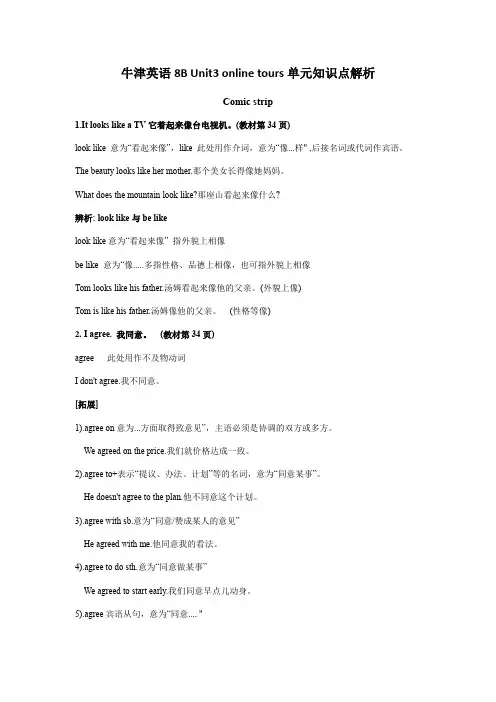
牛津英语8B Unit3 online tours单元知识点解析Comic strip1.It looks like a TV它着起来像台电视机。
(教材第34页)look like 意为“看起来像”,like 此处用作介词,意为“像...样" ,后接名词或代词作宾语。
The beauty looks like her mother.那个美女长得像她妈妈。
What does the mountain look like?那座山看起来像什么?辨析: look like与be likelook like意为“看起来像” 指外貌上相像be like 意为“像.....多指性格、品德上相像,也可指外貌上相像Tom looks like his father.汤姆看起来像他的父亲。
(外貌上像)Tom is like his father.汤姆像他的父亲。
(性格等像)2.I agree. 我同意。
(教材第34页)agree 此处用作不及物动词I don't agree.我不同意。
[拓展]1).agree on意为...方面取得致意见”,主语必须是协调的双方或多方。
We agreed on the price.我们就价格达成一致。
2).agree to+表示“提议、办法、计划”等的名词,意为“同意某事”。
He doesn't agree to the plan.他不同意这个计划。
3).agree with sb.意为“同意/赞成某人的意见”He agreed with me.他同意我的看法。
4).agree to do sth.意为“同意做某事”We agreed to start early.我们同意早点儿动身。
5).agree宾语从句,意为“同意.... "We agree that her answer is right.我们同意地的答案是正确的。
中考●链接He told his parents his ideas about the camping several times , and they___(同意)with him at last.解析:我们可用“语法分析法”解答此题。
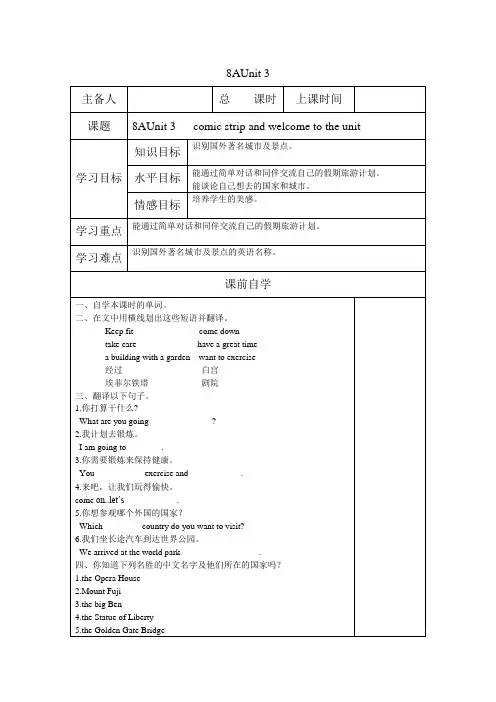
8AUnit 3导学案导学案导学案导学案导学案导学案导学案导学案导学案8A Unit 3参考答案导学案1一、1.boat past 2.coffee 3.president 4.with 5.foreign二、1. How did you arrive at the World Park?2.I took a boat trip under the famous Harbour Bridge and went past the Opera House.3.Did you have a good time when you went out?4.What were they doing when you went past?三、C B C B导学案2一、略。
二、1.School trip 2.coach 3.traffic 4.better 5.excited 6.got off 7.models8.interest 9.amazing三、1.Luckily 2.began 3.chose 4.to visit 5.to lend6.amazing7.taught8.yourself9.beauty 10.saw导学案3一、略二、1.they their 2. us 3.ourselves 4.yourself 5.my 6.yours 7.themselves8.our 9.hers 10. you your mine导学案4一、1.boring 2.invited 3.world 4.beauty 5.traffic二、1.What do you think of the trip?2.How far is it from the school to the park?3.He often goes to New York by plane.4.I go home on my foot after school every day.5. She sometimes rides a bike to school.三、1.take underground to World Park 2.over hundred places interest have no idea3.be careful too much traffic4.at the beginning of the meeting, sang5.on English, grades in导学案5一、1.but 2.or 3.and 4.or 5.and 6.but 7.but二、1. We can go to the Eiffel Tower or visit the pyramids first.2. The music was great but too loud.3. The Golden Gate Bridge was small and looked just like the one in America.4. Would you like some pears or grapes?5. spent on6.take an underground三、1.to go 2. to go 3.passing 4. not to cross5. play6. to buy7.don’t watch8. have四、1. you can go to Sanya or Guilin in the summer holiday.2. They are planning to go travelling tomorrow.3. Look! The children are playing hide-and-seek.4. Jack taught himself how to make a home page last year.导学案 6一、略二、1.help yourselves to 2.will hurt yourself 3.taught herself4.is pulling himself5.enjoyed ourselves6. by himself三、1.himself 2.myself 3.themselves 4. myself 5.themselves四、1.are preparing for 2.to stay at home, of going travelling, too much homework.3.to keep secret fo r each other4.Jiang Ming is ill now, and he can’t go to school.5.go swimming or fishing6.decided to7.planning for a really interesting trip.8.but he can’t solve the problem.导学案7一、1.cheerful 2.winners 3.final 4.supporters 5. receiving 6.cost7. sure 8.arrives 9.per 10.half-time二、1.more than two 2.cost him 3. which sportswoman to support 4.with many useful5.why not go/what about going三、go go go go going导学案8一、1.fact 2.opinion 3.fact 4.opinion 5.opinion二、1.preparing 2.invited 3.excited 4.beauty 5.amazing三、1.to keep fit 2.taught himself 3. take photos 4.is knocking at5. hide-and-seek四、1.ourselves 2.beginning 3.watched 4.are going to fly 5. unpopular导学案9一、略二、1.tries his best to 2.taught himself, home page 3.so many places of interest4. want to take, sunset5.climbs the rocks导学案10一、1. It is sunny and our city looks more beautiful.2. He invited me to the morning assembly but I am too busy to go.3. On Sunday you can go horse riding or listen to pop music at home.4. The little boy is very young but knows more things than the other children.5. My mother can do cooking for me at home or I can go to the restaurant for supper.二、1.stay 2.to do 3.to become to treat 4.to go 5.to pull三、1.yourselves 2.yourself 3.themselves 4.ourselves 5.himself6.myself7.itself8.myself9.himself四、略8A Unit4。
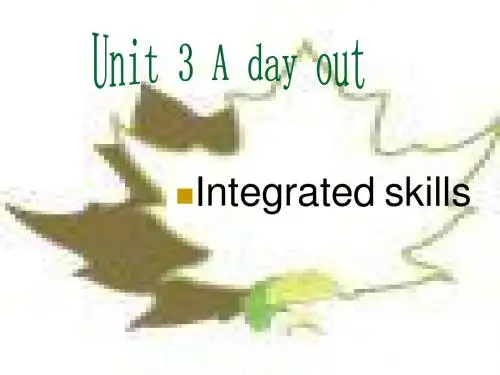
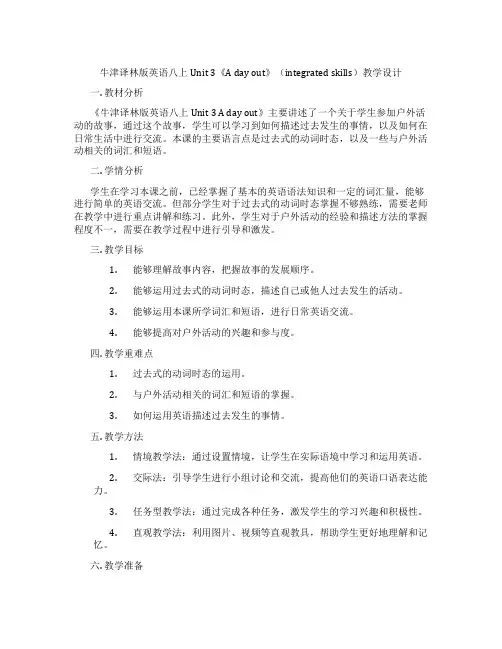
牛津译林版英语八上Unit 3《A day out》(integrated skills)教学设计一. 教材分析《牛津译林版英语八上Unit 3 A day out》主要讲述了一个关于学生参加户外活动的故事,通过这个故事,学生可以学习到如何描述过去发生的事情,以及如何在日常生活中进行交流。
本课的主要语言点是过去式的动词时态,以及一些与户外活动相关的词汇和短语。
二. 学情分析学生在学习本课之前,已经掌握了基本的英语语法知识和一定的词汇量,能够进行简单的英语交流。
但部分学生对于过去式的动词时态掌握不够熟练,需要老师在教学中进行重点讲解和练习。
此外,学生对于户外活动的经验和描述方法的掌握程度不一,需要在教学过程中进行引导和激发。
三. 教学目标1.能够理解故事内容,把握故事的发展顺序。
2.能够运用过去式的动词时态,描述自己或他人过去发生的活动。
3.能够运用本课所学词汇和短语,进行日常英语交流。
4.能够提高对户外活动的兴趣和参与度。
四. 教学重难点1.过去式的动词时态的运用。
2.与户外活动相关的词汇和短语的掌握。
3.如何运用英语描述过去发生的事情。
五. 教学方法1.情境教学法:通过设置情境,让学生在实际语境中学习和运用英语。
2.交际法:引导学生进行小组讨论和交流,提高他们的英语口语表达能力。
3.任务型教学法:通过完成各种任务,激发学生的学习兴趣和积极性。
4.直观教学法:利用图片、视频等直观教具,帮助学生更好地理解和记忆。
六. 教学准备1.教学PPT:包括故事内容、词汇和短语、语法点等。
2.图片和视频素材:与户外活动相关的图片和视频。
3.练习题:针对本课内容设计的练习题。
4.教学道具:如户外活动用品等。
七. 教学过程1.导入(5分钟)老师通过提问方式引导学生谈论自己参加户外活动的经历,激发学生的学习兴趣。
2.呈现(10分钟)老师通过PPT呈现故事内容,让学生整体感知文本。
同时,老师讲解过去式的动词时态,让学生理解和掌握。
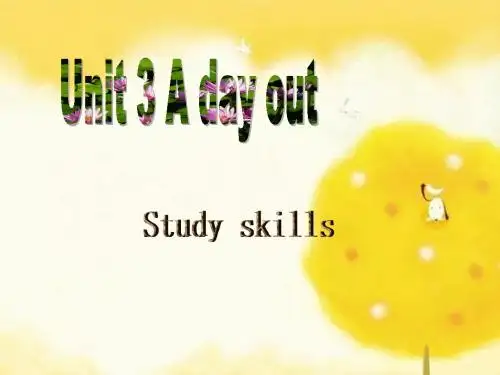
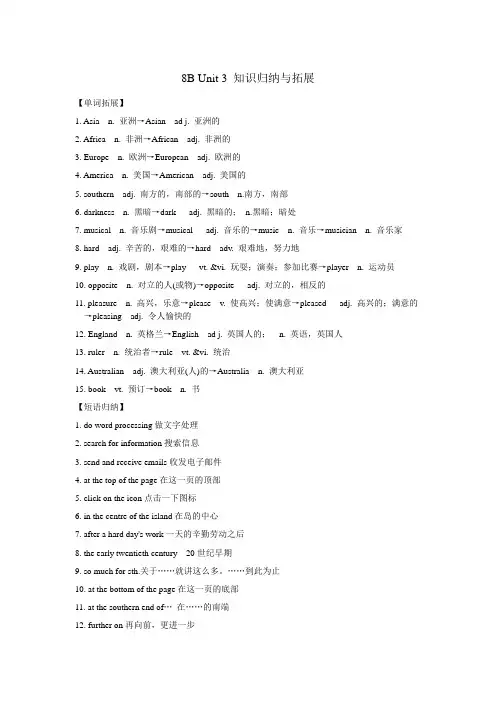
8B Unit 3 知识归纳与拓展【单词拓展】1. Asia n. 亚洲→Asian ad j. 亚洲的2. Africa n. 非洲→African adj. 非洲的3. Europe n. 欧洲→European adj. 欧洲的4. America n. 美国→American adj. 美国的5. southern adj. 南方的,南部的→south n.南方,南部6. darkness n. 黑暗→dark adj. 黑暗的;n.黑暗;暗处7. musical n. 音乐剧→musical adj. 音乐的→music n. 音乐→musician n. 音乐家8. hard adj. 辛苦的,艰难的→hard adv. 艰难地,努力地9. play n. 戏剧,剧本→play vt. &vi. 玩耍;演奏;参加比赛→player n. 运动员10. opposite n. 对立的人(或物)→opposite adj. 对立的,相反的11. pleasure n. 高兴,乐意→please v. 使高兴;使满意→pleased adj. 高兴的;满意的→pleasing adj. 令人愉快的12. England n. 英格兰→English ad j. 英国人的;n. 英语,英国人13. ruler n. 统治者→rule vt. &vi. 统治14. Australian adj. 澳大利亚(人)的→Australia n. 澳大利亚15. book vt. 预订→book n. 书【短语归纳】1. do word processing做文字处理2. search for information搜索信息3. send and receive emails收发电子邮件4. at the top of the page在这一页的顶部5. click on the icon点击一下图标6. in the centre of the island在岛的中心7. after a hard day's work一天的辛勤劳动之后8. the early twentieth century 20世纪早期9. so much for sth.关于……就讲这么多。
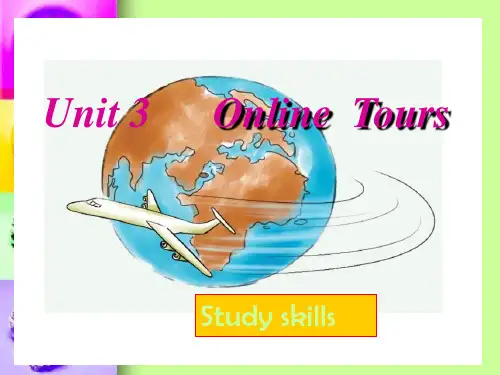
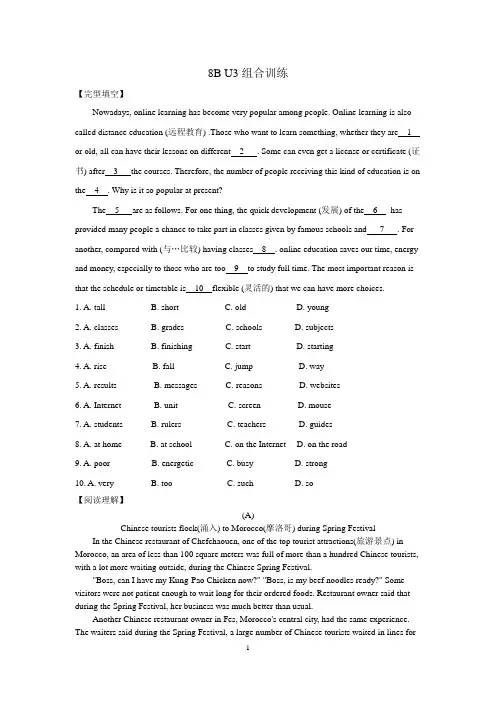
8B U3组合训练【完型填空】Nowadays, online learning has become very popular among people. Online learning is also called distance education (远程教育) .Those who want to learn something, whether they are 1 or old, all can have their lessons on different 2 . Some can even get a license or certificate (证书) after 3 the courses. Therefore, the number of people receiving this kind of education is on the 4 . Why is it so popular at present?The 5 are as follows. For one thing, the quick development (发展) of the 6 has provided many people a chance to take part in classes given by famous schools and 7 . For another, compared with (与…比较) having classes 8 . online education saves our time, energy and money, especially to those who are too 9 to study full time. The most important reason is that the schedule or timetable is 10 flexible (灵活的) that we can have more choices.1. A. tall B. short C. old D. young2. A. classes B. grades C. schools D. subjects3. A. finish B. finishing C. start D. starting4. A. rise B. fall C. jump D. way5. A. results B. messages C. reasons D. websites6. A. Internet B. unit C. screen D. mouse7. A. students B. rulers C. teachers D. guides8. A. at home B. at school C. on the Internet D. on the road9. A. poor B. energetic C. busy D. strong10. A. very B. too C. such D. so【阅读理解】(A)Chinese tourists flock(涌入) to Morocco(摩洛哥) during Spring Festival In the Chinese restaurant of Chefchaouen, one of the top tourist attractions(旅游景点) in Morocco, an area of less than 100 square meters was full of more than a hundred Chinese tourists, with a lot more waiting outside, during the Chinese Spring Festival."Boss, can I have my Kung-Pao Chicken now?" "Boss, is my beef noodles ready?" Some visitors were not patient enough to wait long for their ordered foods. Restaurant owner said that during the Spring Festival, her business was much better than usual.Another Chinese restaurant owner in Fes, Morocco's central city, had the same experience. The waiters said during the Spring Festival, a large number of Chinese tourists waited in lines formeals every day.In the southern Moroccan town of Marrakech, tourist buses full of Chinese tourists can be found everywhere during the Spring Festival.In Majorelle Garden, a famous tourist attraction, two girls from Ningbo, a city in East China's Zhejiang province, said they chose Morocco as their Spring Festival travel place to taste the country's special food.Morocco's Minister of Tourism Mohamed Sajid said it hopes to attract(吸引) 500,000 Chinese tourists each year by 2020.Sajid also said Morocco is working to improve hotels, transports and tourist reception. He said direct flights(直达航班) between Morocco and China are being discussed, which is one of the key factors to attract Chinese tourists.1.Where can we probably find this article?A.In a storybook.B. In a sports magazine.C. In a newspaper.D. In a cookbook.2. What do the two girls from Ningbo come to Morocco for?A. shoppingB. Moroccan foodC. tourist attractionsD. Chinese restaurants3. Which is one of the key factors to attract Chinese visitors?A. hotelsB. transportsC. foodD. direct flights4. Which are famous places of interest in Morocco?A. ChefchaouenB. MarrakechC. Majorelle GardenD. All of the above5. We can infer(推断) from the passage thatA. Chinese restaurants in Morocco can make much money during the Spring Festival.B. There are not many Chinese tourists in Fes.C. Kung-Pao Chicken may be a kind of Moroccan food.D. Sajid is the president of Morocco.(B)Do you enjoy visiting a museum? Did you ever make a plan before a visit? Every museum must have something that attracts you. And there are many possible ways to enjoy yourself in a museum.If you follow these steps below, you'llknow what is worth seeing and doing, so thatyou can make the most of your time at themuseum.Decide what museum you will visit.There are so many different kinds of museumsand you first need to find one that you like. It's easy for you to choose one and start an enjoyable visit!Do some research online. Every museum now has a website which allows you to look through the information about it. On the website, you may look for such things as: •The exhibits(展品)–See what is on show at the museum at all times, and what special exhibitions are held for a short time.•The history of the museum –There will often be very interesting stories about the exhibits and the benefactors(捐赠者). That can make your visit more interesting.•Activities –See whether there are talks, tours our special activities on the day when you visit. Many museums hold some activities that meet the interests of all age groups.•C ost,food or shortage–It's important how much the visit will cost. You have to decide whether or not you can eat there. You might also need to find out transportation needs, as well as storage for coats, bags etc.Learn at least one thing on your visit. It is always good to take away something new from your visit.Plan breaks into your visit. When you walk around, standing here and studying exhibits there, you may become very tired. So it is important to take breaks. A break is a good opportunity for you to think of what you have seen and what else you might want to do in museum.Take a friend or two. Visiting museums is always a lot more fun when you are with someone else. You can talk over what you’re seeing. A friend also brings another way of thinking when you talk about the exhibit.( )6. According to the passage, we should first ____.A. do some research onlineB. make a plan for lunchC. decide on a museum to visitD. choose a friend to go with( )7. To make our visit more interesting, we can____.A. organize activities like special shows and talksB. read the stories about exhibits and benefactorsC. learn about the interests of all age groupsD. walk around the museum without breaks( )8.If we visit a museum with friends, we can____.A. share the experience with themB. come up with strange ideasC. cut down the cost of the visitD. discuss the next visit plan( )9.What does the passage mainly about?A.What to do in a museumB.When to visit a museumC.Where to find a museumD.How to enjoy a museum【阅读表达】"Here is the shopping for Mr Green," said Dad, handing me a big plastic bag. Dad owned a milk bar, and sometimes I helped out after school with deliveries(送货).We had our regulars, but times were hard. Dad said it was the home deliveries that kept us in business. The deliveries included the tea my dad imported(进口)from Fuzhou. Dad was well-known for his tea,and people came from miles around to buy it.I loaded up my bicycle with Mr Green's shopping. His order always included three packets of my dad's tea. How Mr Green could drink that much tea each week was a mystery to me."See you later, Chen," said Dad.He always called me by my Chinese name.My dad's parents came from China in the 1950s. I had a one-yuan coin they brought with them. I cycled out into the sun, wishing I could drive—it would be so much quicker to make deliveries.Dad always said the exercise was good for me. I knew he was right, but I'd already decided that when I left home, the first thing I would do was to buy a car.I loved anything to do with cars, and I'd decided I would be a mechanic, although I knew it wasn't what Dad had in mind for me. He'd already started saying to his friends, "When Chen goesto university..." If that happened,I would be the first person in my family to go,and it would be a great honor for my dad. But it wasn't what I wanted.1.How did the writer's dad keep his business?2.When did the writer's grandparents leave China?3.Did the writer's dad want the writer to go to university? Why?【书面表达】请根据以下提示,写一篇短文,介绍一下你对悉尼的在线之旅。
Unit 6 Pets Reading3日分享:Fight dog , fight bear 。
打个青红皂白,一决雌雄。
课题8B Module 3 Unit 6 Reading (第3课时)学习目标1.深入理解课文细节,学习课文内容及句型结构。
2.进一步掌握相关知识点及其运用。
学习重点掌握知识点及其运用。
学习难点知识点的巩固与灵活运用。
学习过程一、温故知新翻译下列短语:1.长大 ____________________ 2. 向…学习 ____________________ 3.和…玩 ____________________ 4. 照顾 ____________________ 5.需要被清洗 ____________________ 6. 阻止某人做某事____________________ 7.冲…叫 ____________________ 8. 整夜 ____________________ 9.除了…别无选择____________________ 10. 四处自由走动 ____________________二、课堂探究1. According to my mum, this helps us become more responsible people.解析:responsible 是形容词,意为:“有责任的,负责任的”。
例:Simon is a responsible boy. 西蒙是个有责任心的男孩。
Responsibility 是名词,意为:“责任”。
例:We can learn responsibility from keeping dogs.拓展:be responsible for 意为“对。
负责任”。
例:Who was respo nsible for sales? 谁负责销售?2. Pet dogs leave their hair on the floor, on beds and on sofas, and they need to be washed often.解析1:leave 意为:“留下,丢下,落下”,常表示某物落在、忘在某地。
牛津译林英语8B Unit 3知识点一、重要词汇和短语1. use的用法use for 用作eg. We used the seal's fur for coats. 我们用海豹皮做大衣。
used to do 过去经常eg. We used to grow vegetables. 我们过去是种蔬菜的。
use up 用光eg. By this time he had used up all his savings.be used to doing sth. 习惯做某事eg. I'm used to taking a walk after supper. 我习惯餐后散步。
be used to do 被用来做...use out 耗尽= out of useeg. These words have already passed out of current use. 这些词现在己不通用。
2、look like指外表“看起来像”,既可指人也可指物。
Eg.That man looks like our English teacher. 那个人像我们的英语老师。
The strange thing looks like a plate. 那个奇怪的东西看起来像一个碟子。
3、chat with sb和某人聊天/ have a chat with sbEg. He likes chatting with an outgoing person.他喜欢与性格外向的人聊天。
4、speak / say / talk / tell的用法对比speak表示说话的方式,后面一般接语言:She speaks English. 她说英语。
say主要指说话的内容:I am a teacher."he says. 他说我是一名老师。
talk主要指与什么人说话和谈论什么事情,一般和 to,with,about连用比如:He likes talking to/with me. 他喜欢和我交谈。
⽜津英语8B_unit3知识点语法汇总(超级精华).doc(⽜津初中英语总复习) 8B Unit 3⼀.【精选词汇】 ㈠重点短语 1. I have no idea.=I’ve no idea.=I don’t know.我不知道。
(p40) 2. turn on the TV →turn on/off打开/关闭…,turn up/down调⼤/调低;都是“动词+副词”。
3. change the channel换台→on Channel…在…台,e.g. on CCTV-5→拓展:theEnglish Channel英吉利海峡 4. different uses of computers计算机的不同⽤途: draw and design, play computer games, search for information, send andreceive e-mails收发电⼦邮件, do word processing进⾏⽂字处理, write computerprograms编写计算机程序 (p41) 5. travel around the world in eight hours⼋⼩时环游地球,educational CD-ROM教育软件 (p42) 6. come out (书等)出版,发⾏,发表,不能⽤于被动语态,可以转化为bepublished。
〈知识链接〉When will her new novel come out?=When will her new novel bepublished? 〈⽤法拓展〉⑴(太阳、⽉亮或星星)出现;露出,e.g. The rained stopped and〈⽤法拓展〉the sun came out. ⑵(花朵)开放;(草)出芽,e.g. In March flowers and grass come out. 7. learn English and geography at the same time同时学英语和地理→at the sametime同时 〈知识链接〉learn and play at the same time边学边玩 8. the main character主⾓→play the main character of…=play the lead roleof… 〈知识链接〉play the role…扮演…,the best actor最佳男主⾓,the bestactress最佳⼥主⾓ 9. have/get itchy feet渴望旅⾏,e.g. She has gone to Australia-she has alwayshad itchy feet. 10. help you learn English by testing your knowledge of English grammar andvocabulary (p43) 〈知识链接〉〈知识链接〉⑴by介词,通过某种⽅法、⼿段,后接名词或动词-ing。
牛津译林版八年级英语上册教案Unit3Reading一、教学内容本节课选自牛津译林版八年级英语上册Unit3 Reading部分,主要讲解章节为“A day out”,内容详细描述了一家人在公园度过一天的场景,包括描述了公园的自然景观、活动项目以及家庭之间的亲情互动。
二、教学目标1. 能够理解并运用文本中的重点词汇和句型进行日常交流。
2. 能够掌握一般过去时的用法,并运用到实际情境中。
3. 能够理解文本内容,把握文章主旨,提高阅读能力。
三、教学难点与重点1. 教学重点:掌握一般过去时,运用重点词汇和句型进行交流。
2. 教学难点:理解并运用一般过去时描述过去发生的事情。
四、教具与学具准备1. 教具:PPT、黑板、录音机、磁带。
2. 学具:课本、练习本、字典。
五、教学过程1. 导入:通过展示一组公园游玩的照片,引发学生对主题的思考,激发学习兴趣。
2. 阅读前:引导学生预测文章内容,进行头脑风暴,激活背景知识。
3. 阅读中:让学生快速阅读文本,了解文章大意;接着详细阅读,理解文章细节;通过问题链的形式,检查学生对文本的理解。
4. 阅读后:进行小组活动,让学生运用一般过去时,描述自己的一次公园游玩经历。
5. 例题讲解:针对一般过去时进行讲解,并通过例题让学生进行实际操作。
6. 随堂练习:设计练习题,让学生巩固所学知识。
六、板书设计1. Unit3 Reading A day out2. 重点词汇:hill、boating、visit、picnic、enjoy等。
3. 重点句型:We visited the park last weekend. We had a picnic on the hill.4. 一般过去时的构成:主语 + 动词过去式 + 其他。
七、作业设计1. 作业题目:(1)根据课文内容,完成填空题。
(2)运用一般过去时,写一篇关于自己一次公园游玩的短文。
答案:(1)略。
Last weekend, I went to the park with my family. Wevisited the hill and had a picnic there. We also went boating on the lake and enjoyed the beautiful scenery. It was a wonderful day out!八、课后反思及拓展延伸1. 反思:本节课通过实践情景引入、例题讲解和随堂练习,让学生掌握了重点知识。
牛津英语8B Unit3导学案一、教材分析:本单元的主题为“电脑”,Comic Strip部分通过Hobo与Eddie之间的对话,激发了学生对本单元的兴趣,唤起他们网上旅游学习文化知识的欲望,也引出了本单元的语法重点---被动语态;Welcome to the unit 中让学生根据图片选填正确的电脑用途,旨在帮助学生了解英语掌握电脑的基本用途即基本功能;Reading介绍了一种虚构的、有趣的教育类游戏光盘。
游戏玩家扮演主人公“痒痒脚”。
它在梦里旅游,行程中他必须回答各种问题,测试自己的英语语法和词汇能力以及地理知识。
V ocabulary通过图片向学生介绍电脑部件名称,旨在帮助学生用恰当的词汇来谈论计算机的功能和用途。
Grammar分A、B两部分介绍了“被动语态”的基本用法、结构以及用介词by来引出“动作执行者”在A部分通过Millie到商店购买电脑谈论电脑的相关情况及用本单元已经学过的词汇来谈论电脑部件及其功能,在B部分以一种虚构的教育类光盘“Saving Princess Laura”话题,帮助学生掌握“被动语态”的结构。
Integrated Skills以一种计算机教育软件的内容为主线,通过听力材料用相关的词汇来向他人介绍其它计算机教育软件,并向他人请求帮忙解决如何在电脑上使用教育类软件划。
Study skills教会学生根据不同类型的信息将词汇和观点进行分类。
Main task一块描述自己最喜欢的教育类游戏光盘为例,鼓励学生写出他们自己最喜欢的教育类光盘,以此训练学生的听、说、读、写一系列技能。
Checkout 一块继续以介绍电脑部件、用途及其功能为例,进一步复习并巩固“被动语态”与计算机相关词汇的正确使用。
二、教学三维目标:知识目标:1. 学习电脑部件名称、用途及其相关的词汇;2. 了解相关的有趣的教育类游戏光盘;3. 学习并使用一般现在时、一般过去时的被动语态,包括由by引出动作的执行者能力目标:1. 能根据关键词、图片、上下文和已有知识猜测文章大意和掌握具体细节,并能运用自己已经掌握的描写自己感兴趣的教育类关盘;2. 能用被动语态的一般现在时和一般过去时来谈论感兴趣的相关话题;3. 能询问和回答有关使用计算机教育然间的细节信息,并能根据不同类型的信息将词汇和观点进行分类情感目标:1. 通过了解有关教育类游戏关盘的信息,激发学生对使用教育类光盘或软件的兴趣;2. 唤起学生网上旅游学习的欲望,感受网上学习的乐趣。
三、教学重点和难点教学重点:1. 学习、了解和掌握有关计算机部件的名称、用途及其功能,通过本单元的学习,能描述自己最喜欢的教育类游戏关盘;2. 学习掌握被动语态的意义、结构及其一般现在时和一般过去时的正确运用;3. 理解词汇和观点之间的关系,并根据不同类型的信息极爱那个词汇和观点进行分类。
教学难点:1. 有关计算机部件的名称、用途及其功能的词汇及其运用;2. 被动语态的结构及其一般现在时和一般过去时的正确运用;3. 如何描述教育类游戏光盘软件。
四、学情分析和教学建议计算机这个话题,对学生来说并不都不陌生,在经过一年半的学习,学生的英语词汇已经比较丰富,口头表达也到了一定的水平,所以学生根据对电脑的已有知识描述初一二,在交流中更能激起智慧的火花,唤起他们电脑的更大兴趣以及电脑在学习中使用的欲望。
教学中教师可以采用Role-playing; Cooperating; Pre-reading; While-reading; Post-reading; brainstorming; listening for special information等教学、学习策略,创设贴近生活的情境,利用学生对电脑的已有知识及老师制作的多媒体课件来展开课堂Work alone, Pair work, Group work 等口语交际活动,让学生在声情并茂的语境中掌握知识,激起语言学习的乐趣。
词汇教学可以通过贴近学生生活实际的例子,由易到难,增加对词汇的理解及掌握;听力与口语教学以角色扮演、模仿对话或复述短文为主,强调对主要信息的获取和输出;阅读教学可以采用“任务型”阅读教学模式来帮助学生理解教育类游戏光盘的星光知识,教学中,老师可以降低难度,帮助帮助学生学习理解和掌握相关的词汇,并借助多媒体把不熟悉的景点真实化、情境化,进而让枯燥的文章趣味化;写作教学在帮助学生了解和掌握写作要求的基础上、以模仿写作为主;语法教学旨在引导学生掌握规律,反复模仿操练,对于被动语态,其中的一般现在时和一般过去时的结构及其运用是难点,提醒学生要进行比较记忆,并反复练习、理解、巩固以达到熟练运用程度。
五、课时安排Comic strip & Welcome to the unit: one periodReading: two periodsV ocabulary: one periodGrammar: one periodIntegrated skills: two periodsStudy skills: one periodMain task: one periodCheckout: one periodPeriod 1:Welcome to the unit一、教学三维目标:知识目标:1. 介绍电脑;2. 激活现有词汇并掌握与主题有关的生词词义;3. 根据图片,学习了解电脑的正确用途。
技能目标:1. 根据图片猜测词义;2. 用新学词汇谈论电脑的基本用途。
情感目标:1. 激发学生对学习电脑知识的欲望二、教学重点:词汇: online; television; program; look like; turn on; search for information; send and receivee-mails; computer programs词组:have on idea, look like, remote control, turn on, change the channel, search for information, send and receive e-mails, use sth. to do…, write computer programmes, word processing重点句型:1.I have no idea.have no idea 后面可以接of 短语或从句。
2.Look, the TV is turned on now.turn on / turn off/ turn down/ turn up3.what do you usually use your computer to do?/ what do you usually use yourcomputer for?use sth. to do…4.I usually use it to search for information.search for sth/ search sth 的区别search sb. or a place for sth预习案:一、翻译下列短语1. 不知道2. 看上去像3. 同意某人的观点4. 遥控器5. 打开电视6. 选择领导7. 举行一场写作比赛8. 搜索有用信息9. 发送和接受电子邮件10 玩游戏11. 编制电脑程序12. 画画与设计13. 文字处理14. 换频道二、写出单词的中文解释及其英标1. monitor2. mouse3. keyboard4. printer5. document6. modern7. disk三、句型转换1. I‘m afraid I‘ve no idea. I‘m afraid I ______ _______.2. Tom will say ―Yes‖ to me. Tom will ______ _____ me.3. The boy turns on the TV now. The TV _______ _______ _______ now.4. What do you use the computer for?What do you use the computer ______ _______?5. I use the computer to search for information.The computer is _______ _______ search for information.教学设计:I. Lead-in1. Questions about computer: What do you usually do when you are free? Do you have a computer at home?Do you like playing computer games?2. Present new sentences: What do you use your computer for? The TV is turned on.3. Introduce the main task for this unit: ComputerII. Pre-taskTask 1:Present some pictures of the different parts of the computer; and some descriptions about them. Help the studentsunderstand what they mean.Task 2: Expression build-up.III. While-taskTask 1: Present the pattern: What do you use the computer for? I usually use it to …Task 2: Pair work: Ask and answer about Part A with the pattern above.Task 3: Introduce Part B, and have two students to read out the conversation between Daniel and Simon.Ⅳ. Post-taskTask 1: Pair work: Help the students make conversations about thedifferent parts and their functions of a computer, using the conversation between Daniel and Simon as a model.V. HomeworkVI: Class-work课堂巩固练习案一.根据句意、首字母或汉语提示完成下列句子。